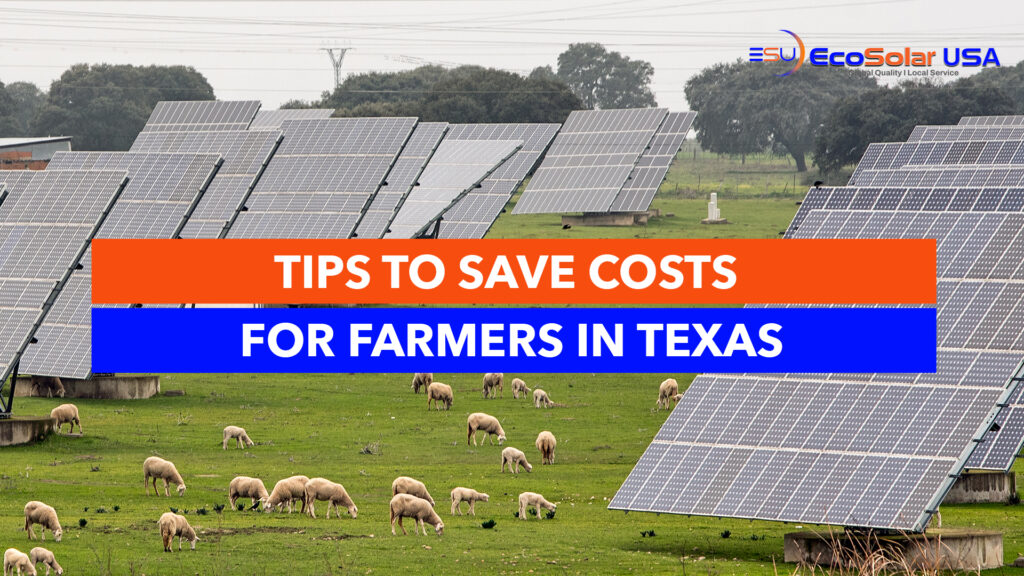
Running a farm in Texas is as challenging as it is rewarding. Between fluctuating fuel prices, rising electricity costs, unpredictable weather, and water shortages, every dollar counts. Smart energy and resource management can make a major difference to your bottom line.
In this guide, we’ll cover practical ways for Texas farmers to reduce costs, from upgrading equipment and managing irrigation more efficiently to investing in solar energy for long-term savings.
1. Understand Your Farm’s Energy Use
The first step to cutting costs is knowing where your energy goes. On most Texas farms, the biggest expenses come from:
| Energy Use | % of Total Cost | Examples |
| Irrigation Pumps | 25–35% | Electric or diesel pumps for crops and livestock |
| Lighting & Heating | 15–25% | Barns, poultry houses, equipment sheds |
| Cooling & Ventilation | 10–20% | Livestock cooling fans, refrigeration, grain storage |
| Processing Equipment | 10–15% | Grain dryers, conveyors, feed mills |
| Miscellaneous | 5–10% | Office, fencing, maintenance tools |
👉 Start with an energy audit—available through local utilities or the USDA’s REAP (Rural Energy for America Program)—to identify where you can save.
2. Go Solar to Power Your Farm
Texas ranks #2 in the U.S. for total solar potential, making it an ideal state for farmers to switch to renewable power. Solar can dramatically cut your electric bills and hedge against future energy price spikes.
| System Size | Estimated Cost (Before Incentives) | After 30% Federal Tax Credit | Monthly Savings |
| 25 kW (small operation) | ~$60,000 | ~$42,000 | $700–$900 |
| 50 kW (medium farm) | ~$120,000 | ~$84,000 | $1,500–$2,000 |
| 100 kW (large farm) | ~$240,000 | ~$168,000 | $3,000–$4,000 |
Incentives for Texas Farmers:
- 🌞 Federal Solar Tax Credit (30%) – Available through 2032 for installations on agricultural land or facilities.
- 🐄 USDA REAP Grant – Covers up to 50% of renewable energy project costs for agricultural producers and rural small businesses.
- 💧 Texas Property Tax Exemption – The added solar value is exempt from property tax increases.
With these incentives, your solar investment can pay for itself in 4–7 years and deliver decades of free energy.
3. Optimize Irrigation Systems
Water and energy are deeply connected on Texas farms. Inefficient irrigation wastes both.
- Replace old pumps with variable frequency drives (VFDs) — they adjust speed based on water demand and can cut power use by 20–40%.
- Install drip irrigation to reduce water and energy consumption by 30–50%.
- Monitor soil moisture with smart sensors to avoid overwatering.
- Schedule irrigation during off-peak energy hours when rates are lower.
These small changes can lead to huge savings, especially in areas like the Rio Grande Valley, Lubbock, or Central Texas where irrigation costs are high.
4. Improve Cooling and Ventilation
If you run livestock or poultry operations, cooling and ventilation systems are often a top expense.
- Use energy-efficient fans and maintain them regularly.
- Install automatic thermostats or smart ventilation controls.
- Shade barns with natural vegetation or reflective roofing materials.
- Upgrade to high-efficiency motors for fans and blowers.
According to Texas A&M AgriLife Extension, efficient ventilation systems can reduce energy use by 15–25% annually.
5. Upgrade to Energy-Efficient Lighting and Equipment
Lighting in barns, greenhouses, or workshops adds up quickly.
| Upgrade | Energy Savings | Payback Period |
| Replace halogen with LEDs | 60–80% | < 1 year |
| Motion sensors in barns | 10–20% | < 1 year |
| High-efficiency grain dryers | 15–25% | 3–5 years |
Look for Energy Star-rated equipment and check with your local electric co-op for rebates on efficiency upgrades.
6. Maintain Your Machinery
Regular maintenance not only prevents breakdowns but also saves fuel.
- Keep tires properly inflated on tractors and trucks.
- Change filters and fluids on schedule.
- Use GPS-guided precision farming tools to reduce overlap and wasted fuel.
According to the USDA, efficient machinery operation can cut diesel use by 10–15%, translating to thousands in annual savings.
7. Use Grants and Programs for Farmers
Several state and federal programs are available to help Texas farmers reduce energy costs:
| Program | Description | Funding Type |
| USDA REAP | Renewable energy systems & efficiency upgrades | Up to 50% grant |
| Texas PACE Program | Clean energy financing for agricultural & commercial properties | Low-interest loans |
| Oncor & CPS Energy Rebates | Incentives for efficiency upgrades & solar | Cash rebates |
| NRCS EQIP | Covers part of cost for irrigation efficiency and conservation | Cost-share program |
These programs can help offset upfront costs and make upgrades more affordable.
8. Combine Energy Savings with Sustainability
Reducing energy costs doesn’t just help your budget—it boosts your farm’s sustainability. A growing number of Texas agricultural buyers and distributors now prefer working with low-carbon, energy-smart suppliers. Going green is both a financial and marketing advantage.
Texas farmers face unique challenges — from unpredictable weather to rising energy prices — but they also have some of the best opportunities in the U.S. for solar power, energy efficiency, and sustainability programs.
By taking advantage of renewable energy incentives, efficient irrigation, and smart equipment upgrades, you can lower your operating costs, improve resilience, and increase profits for the long term.
If you’re ready to explore solar energy or energy-saving solutions for your Texas farm, contact Eco Solar USA. With over a decade of experience serving Texas and California, we partner with trusted brands like Tesla, Enphase, Maxeon, and Hyundai Solar to deliver high-performance solar systems for farms and rural businesses.



